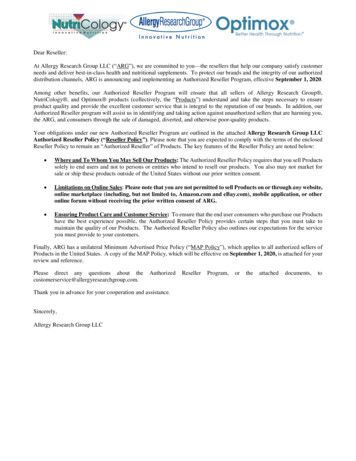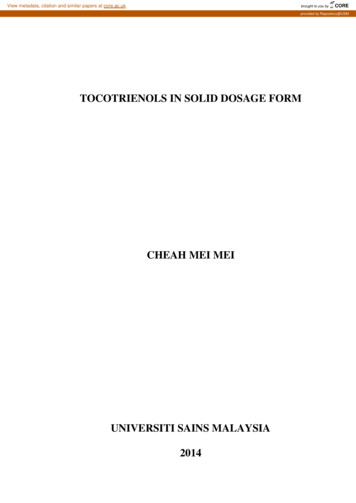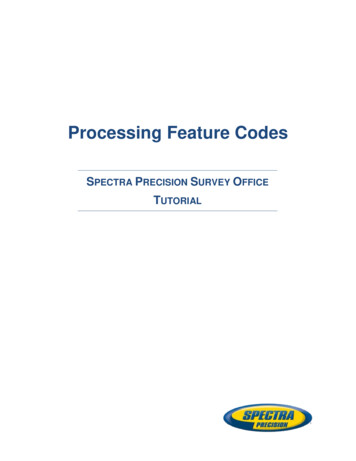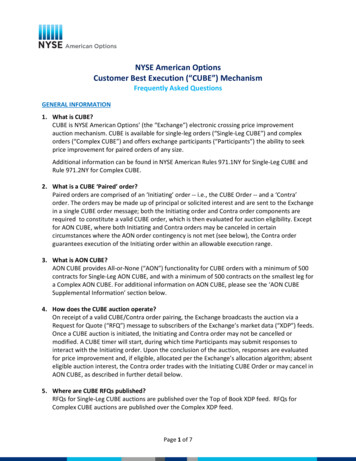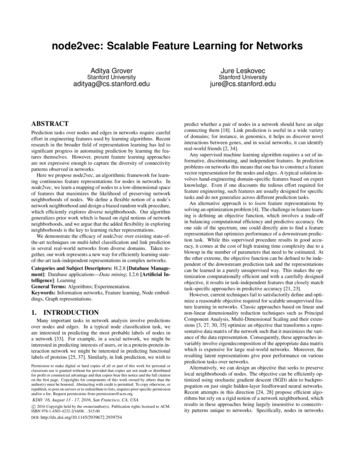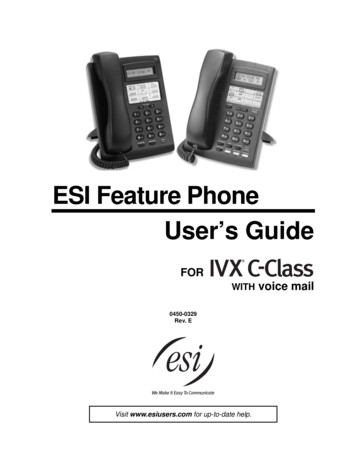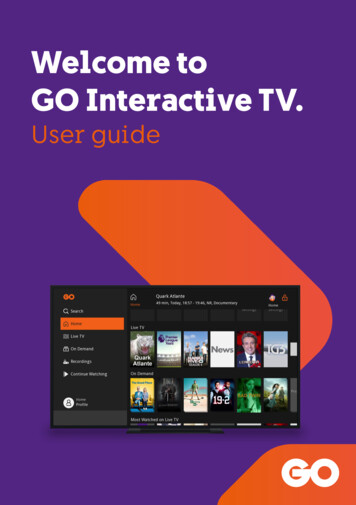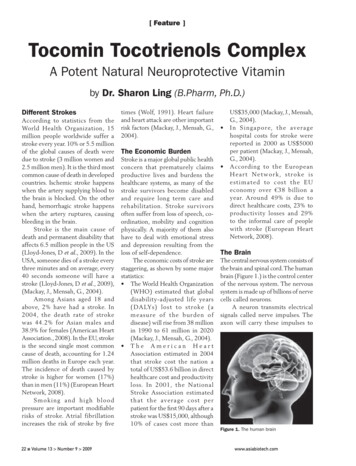
Transcription
[ Feature ]Tocomin Tocotrienols ComplexA Potent Natural Neuroprotective Vitaminby Dr. Sharon Ling (B.Pharm, Ph.D.)Different StrokesAccording to statistics from theWorld Health Organization, 15million people worldwide suffer astroke every year. 10% or 5.5 millionof the global causes of death weredue to stroke (3 million women and2.5 million men). It is the third mostcommon cause of death in developedcountries. Ischemic stroke happenswhen the artery supplying blood tothe brain is blocked. On the otherhand, hemorrhagic stroke happenswhen the artery ruptures, causingbleeding in the brain.Stroke is the main cause ofdeath and permanent disability thataffects 6.5 million people in the US(Lloyd-Jones, D et al., 2009). In theUSA, someone dies of a stroke everythree minutes and on average, every40 seconds someone will have astroke (Lloyd-Jones, D et al., 2009),(Mackay, J., Mensah, G., 2004).Among Asians aged 18 andabove, 2% have had a stroke. In2004, the death rate of strokewas 44.2% for Asian males and38.9% for females (American HeartAssociation., 2008). In the EU, strokeis the second single most commoncause of death, accounting for 1.24million deaths in Europe each year.The incidence of death caused bystroke is higher for women (17%)than in men (11%) (European HeartNetwork, 2008).Smoking and high bloodpressure are important modifiablerisks of stroke. Atrial fibrillationincreases the risk of stroke by five22 Volume 13 Number 9 2009times (Wolf, 1991). Heart failureand heart attack are other importantrisk factors (Mackay, J., Mensah, G.,2004). The Economic BurdenStroke is a major global public healthconcern that prematurely claimsproductive lives and burdens thehealthcare systems, as many of thestroke survivors become disabledand require long term care andrehabilitation. Stroke survivorsoften suffer from loss of speech, coordination, mobility and cognitionphysically. A majority of them alsohave to deal with emotional stressand depression resulting from theloss of self-dependence.The economic costs of stroke arestaggering, as shown by some majorstatistics: The World Health Organization(WHO) estimated that globaldisability-adjusted life years(DALYs) lost to stroke (ameasure of the burden ofdisease) will rise from 38 millionin 1990 to 61 million in 2020(Mackay, J., Mensah, G., 2004). The American HeartAssociation estimated in 2004that stroke cost the nation atotal of US 53.6 billion in directhealthcare cost and productivityloss. In 2001, the NationalStroke Association estimatedt h a t t h e av e ra g e c o s t p e rpatient for the first 90 days after astroke was US 15,000, although10% of cases cost more than US 35,000 (Mackay, J., Mensah,G., 2004).I n S i n g a p o r e, t h e av e ra g ehospital costs for stroke werereported in 2000 as US 5000per patient (Mackay, J., Mensah,G., 2004).According to the EuropeanHeart Network, stroke isestimated to cost the EUeconomy over 38 billion ayear. Around 49% is due todirect healthcare costs, 23% toproductivity losses and 29%to the informal care of peoplewith stroke (European HeartNetwork, 2008).The BrainThe central nervous system consists ofthe brain and spinal cord. The humanbrain (Figure 1.) is the control centerof the nervous system. The nervoussystem is made up of billions of nervecells called neurons.A neuron transmits electricalsignals called nerve impulses. Theaxon will carry these impulses toFigure 1. The human brainwww.asiabiotech.com
[ Feature ]dendrites which deliver them to thereceiving cells or fibers.The central nervous system doesnot regenerate. Therefore, neuronalloss from stroke is permanentalthough limited function can beregained by transferring the tasks toother neurons – a slow process whichhappens in stroke rehabilitation.Glutamate is a neurotransmitter– a group of molecules that allowneurons to communicate with eachother (Figure 2.). When there isexcessive concentration of glutamate,neuronal death results. Ischemia,hypoxia (oxygen deprivation), braintrauma, seizures, various forms ofdementia are all potential causes ofglutamate toxicity.it is a natural vitamin E that isneuroprotective. The efficacy isproven by extensive research.Tocomin Tocotrienols asNeuroprotective VitaminThe vitamin E family compriseseight chemically distinct compounds:4 tocopherols and 4 tocotrienols(alpha, beta, gamma and delta).Tocotrienols differ from tocopherolsby having an unsaturated side tailthat results in significantly differentbiological activities (Figure 3).Tocomin is a natural tocotrienolcomplex concentrated from virgincrude palm oil through a patentedmild extraction process whichFigure 2. Diagrammatic representation of how electrical impulses are transmitted betweenneurons.ensures maximum preservationof phytonutrients. It containspredominantly full spectrumtocotrienols and other phytonutrientssuch as tocopherols, plant squalene,phytosterols, co-enzyme Q10and mixed carotenoids that arenaturally extracted together withtocotrienols.The EvidenceTo c o t r i e n o l c o n f e r sneuroprotection through 2 mainfunctions: its powerful antioxidantactivity and mechanisms other thanantioxidant function. Deficiency ofvitamin E is a cause of neurologicaldysfunction. The brain is highlysusceptible to oxidative damage dueto high oxygen consumption which iscontinuous and independent of degreeof physical activity. Furthermore, thehigh lipid content of the brain makesit susceptible to lipid peroxidation inan antioxidant poor environment.Tocotrienol is 40 – 60 timesmore potent than α-tocopherolin protecting brain cells fromperoxidation (Kamat JP, 1995).Treatments AvailableStroke is best prevented forneuron loss is irreversible. Currently,available medical treatment forthe prevention of stroke includesc h o l e s t e r o l l o w e r i n g d r u g s,antihypertensives and anticoagulantagents such as aspirin. However, thesedrugs often produce undesirable sideeffects and require strict monitoringon the dosage.There are very few compoundsthat have neuroprotective properties.Although quite a number ofhomeopathic treatments and herbsclaim to be protective against stroke,the documented efficacy of thesecompounds remains controversial.To c o t r i e n o l i s u n i q u e a swww.asiabiotech.comFigure 3. Chemical structures of Tocopherol and Tocotrienol. Note the 3 double bonds inthe tocotrienol side tail.Volume 13 Number 9 2009 23
[ Feature ]The higher efficiency ofα-tocotrienol in protecting braincells from oxidative damage couldbe due to the unsaturated side chain oftocotrienol allows for moreefficient penetration into tissuesthat have saturated fatty layers,such as the brain and liver tocotrienols are recycled /regenerated more effectively tobe used again tocotrienols interact betterwith lipid radicals due to strongerdisordering of cell membrane andhigher mobilityTocotrienol prevents neurondeath by other mechanisms unrelatedto its antioxidant activity. In a numberof NIH-sponsored studies, Researchersat the Ohio State Medical Centershowed that α-tocotrienol, but notα-tocopherol, prevented neuron’sdeath at extremely low concentration(nanomolar, 10-9) by regulating specificmediators of cell death (Sen CKet al., 2000). Tocotrienol-treatedneurons maintained healthy growthand motility even in the presenceof excess neurotoxic agent. Theneuroprotective property seen atsuch low concentration of tocotrienolis independent of its antioxidantactivity, as tocotrienols do not exhibitantioxidant properties at nanomolarconcentrations. Tocotrienols onlybegin to show their antioxidanteffects at micromolar concentrations(Khanna et al., 2006).The same researchers wento n t o d e m o n s t ra t e t h a t o ra lsupplementation of tocotrienols(Tocomin , Carotech Inc.) reachesrats’ brain in concentration thatprotected against stroke. There isreduced volume of cerebral infarctin tocotrienol-supplemented ratscompared with un-supplementedcontrols (Khanna S et al., 2005).A further study showed that24 Volume 13 Number 9 2009Tocomin SupraBio (CarotechInc.) supplementation in healthywomen achieved plasma levels oftocotrienols 12 to 30 times more thanthe concentration of α-tocotrienolrequired to completely preventstroke-related neurodegeneration(Khosla P et al., 2006).The patented SupraBio system is a self-emulsifying deliverysystem that provides more consistentand enhanced oral absorption oftocotrienols. It contains a mixtureof oil and surfactants at an optimumratio that will self-emulsify in thegastrointestinal tract. Further reactionswill generate conditions essential foroptimal absorption of tocotrienols.This novel delivery system results inrapid and consistent absorption oftocotrienols independent of dietaryfat or food intake. Clinical study onhealthy human volunteers confirmedthe efficacy of SupraBio system,which increases the rate and extentof tocotrienol absorption by up to300% (Figure 4) (Ho D et al. USPatent 6596306).Looking at NeuroprotectiveEffects of TocotrienolsA collaborative work betweenresearchers from the Malaysian PalmOil Board, University of ScienceMalaysia and Hovid Berhad, thisrandomized double blind placebocontrolled human study is on courseto recruit some 400 participantsover the next few years to study theneuroprotective effects of tocotrienolsby looking at white matter changesusing magnetic resonance imaging(MRI) (ClinicalTrials.gov, 2008).This allows the researchers to lookinto early changes of the brainwithout having to wait for an overtclinical endpoint such as a clinicalstroke.The secondary objectives ofthis human study include evaluatingthe effects of tocotrienols on bloodparameters such as total lipidprofile, Apo-B, C-reactive protein,antioxidant profile, Lp(a) and lipidperoxidation.White matter lesionsWorld’s Largest Clinical TrialFigure 4. Mean plasma alpha-tocotrienol versus time curve of the conventional preparationand SupraBio system.www.asiabiotech.com
[ Feature ]White matter lesions as detectedon magnetic resonance imaging(MRI) (Figure 5) are closely relatedto vascular events of the brain. MRIand histopathological study hasshown that the larger white matterlesions not usually conforming tousual areas of infarcts can actuallyrepresent areas of subclinical infarct(Marshall et al., 1988). In addition,there is positive correlation betweenwhite matter lesions and establishedvascular risk factors (Murray et al.,2005). Several recent studies showedthat white matter hyperintensitiesmay be an independent prognosticmeasure of future stroke risk.The Rotterdam Scan Studyan independent predictor of risk forstroke from arteriolosclerosis, whileprogression of white matter lesionsduring follow up may be associatedwith subsequent stroke in patientswith initially mild white matterlesions. (Yamauchi et al., 2002).Even though the nature of whitematter hyperintensities on MRI is byno means totally understood, thesedata clearly demonstrated that whitematter lesion as detected on MRI isclosely related to vascular events ofthe brain and in certain instancesrepresent subclinical infarcts. Itis therefore conceivable to studythe neuroprotective properties oftocotrienol supplementation inhumans by observing serial changesof white matter disease load in thebrain.Study Protocol in BriefFigure 5. MRI showing white matter lesions(arrows).showed that elderly people withsilent brain infarcts and white matterlesions are at significantly higher riskof clinical stroke, which could not beexplained by the major stroke riskfactors alone (Vermeer et al., 2003).Persons with white matter lesionshave an increased risk of clinicalstroke. Those with both white matterlesions and retinopathy have a muchhigher risk of clinical stroke (20% vs1.4%) (Wong et al., 2002). Severewhite matter lesions is shown to bewww.asiabiotech.com400 subjects will be recruited forstudy on blood profiles. Among them,120 subjects will have MRI. The MRI(both positive and negative) subjectswill be randomized to receiveplacebo or 200mg tocotrienols(Tocovid SupraBio , HovidBerhad) twice a day. Over the courseof 24 months, MRI images will betaken at baseline, 12 months and 24months. Blood profile studies will bedone bimonthly over 12 months.At the point of writing, thehuman study is in progress withclose to 400 volunteers having beenimaged. There are over 100 MRI thatare positive for white matter lesionand randomized to receive placeboor tocotrienol treatment. Some of thepositive cases are undergoing secondimaging.economy is enormous especiallywhen the population ages as strokeis more common in the elderly.Modifying lifestyle and habits suchas increasing physical activities andsmoking cessation, might reduce therisk of stroke.Tocomin palm tocotrienolscomplex shows neuroprotectiveeffects in many studies including anumber of NIH-funded studies.The first study of its kind and theworld’s largest clinical trial utilizingMRI of brains to evaluate the efficacyof tocotrienols in neuroprotectionand antiatherogenic function iscurrently under way. The results ofthis clinical trial will shed more lighton the benefits of palm tocotrienolcomplex (Tocomin , CarotechInc.) in both acute neurologicaldisorders (e.g. stroke) and chronicneurodegenerative disorders (e.g.Alzheimer’s disease; Parkinson’sdisease). The impact of stroke onquality of life and theeconomy is enormousespecially when thepopulation ages asstroke is more commonin the elderly.Summary/ConclusionGlobally, stroke is the 3rd mostcommon cause of death, after heartdisease and cancer. The impact ofstroke on quality of life and theVolume 13 Number 9 2009 25
[ Feature ]BiographyDr. Sharon Ling (B.Pharm, Ph.D.), Vice President, Scientific Affairs,Carotech Ltd. graduated top of the class with an honours (1st class) degreein Pharmacy from The National University of Malaysia. She receivedthe Royal Student Award & University Gold Medal for being the bestoverall graduate of the university in 2000. She later obtained a Ph.D. inPharmaceutical Technology from The School of Pharmaceutical Sciences,University of Science Malaysia. Subsequently she joined Hovid Ltd. as theProduct Research Manager responsible for the research and developmentof pharmaceutical and nutraceutical products. She has been an investigatorin over 30 human clinical studies, many of which related to palm-basedphytonutrients. She has been a popular speaker at numerous internationalconferences, universities, hospitals and community organizations on topicsincluding biopharmaceuticals, bioenhanced and controlled release drugdelivery systems, palm nutraceuticals and phytonutrients. She is currentlythe Vice President, Scientific Affairs, Sales & Marketing for Carotech Ltd.based in the United Kingdom.About CarotechCarotech, a public listed company in Malaysia ACE Market (formerly MESDAQ Board) is the first and largestGMP certified producer of natural full spectrum tocotrienol complex, natural mixed carotene complex andphytosterol complex in the world via its patented technology. Carotech is a subsidiary of Hovid Berhad(www.hovid.com), one of the largest GMP-certified pharmaceutical companies in Malaysia. Carotechmanufactures these products under the tradenames: Tocomin , Tocomin SupraBioTM, Caromin andStelessterolTM. These products are Non-GMO, Kosher and Halal certified.Websites: www.carotech.net, www.tocotrienol.orgEmail: info@carotech.netFor more information, please contact:Carotech Ltd.Europe Sales & Marketing OfficeBuckinghamshireUnited KingdomTel : 44(0)7541966007Email :sling@carotech.net, info@carotech.netWebsites: www.carotech.net. www.tocotrienol.org26 Volume 13 Number 9 2009www.asiabiotech.com
[ Feature ]ReferencesAmerican Heart Association. (2008). Asian/Pacific Islanders and Cardiovascular Diseases :Statistics. Statistical Fact Sheet - Populations 2008 Update.ClinicalTrials.gov. (2008). Neuroprotective and Cardioprotective Effects of Palm Vitamin ETocotrienols. ClinicalTrials.gov Identifier NCT00753532.European Heart Network. (2008). European Cardiovascular Disease statistics, 2008 Edition.Ho D et al. (n.d.). Drug delivery system: formulation for fat-soluble drugs. US patent6596306.Kamat JP, D. T. (1995). Tocotrienols from palm oil as potent inhibitors of lipid peroxidation andprotein oxidation in rat brain mitochondria. Neuroscience Letter, 195, 179-182.Khanna S et al. (2006). Characterization of the potent neuroprotective properties of the naturalvitamin E alpha-tocotrienol. J. Neurochem, 98(5), 1474-1486.Khanna S et al. (2005). Neuroprotective Properties of the Natural Vitamin E alpha-Tocotrienol.Stroke, 36, e144-e152.Khosla P et al. (2006). Postprandial levels of the natural vitamin E tocotrienol in humancirculation. Antioxid Redox Signal, 8(5-6), 1059-1068.Lloyd-Jones, D et al. (2009). Heart Disease and Stroke Statistics 2009 Update. A report fromthe American Heart Association Statistics Committee and Stroke Statistics Subcommittee.Circulation, 119, e1-e161.Mackay, J., Mensah, G. (2004). The Atlas of Heart Disease and Stroke. World Health Organization:Nonserial Publication.Marshall VG et al. (1998). Deep white matter infarction: Correlation of MR imaging andhistopathologic findings. Radiology, 237, 517-522.Murray AD et al. (2005). Brain white matter hyperintensities: relative importance of vascularrisk factors in nondemented elderly people. Radiology, 237, 251-257.Sen CK et al. (2000). Molecular Basis of Vitamin E Action. Tocotrienol potently inhibitsglutamate-induced pp60 c-Src Kinase activation and death of HT4 neuronal cells. J Biol Chem,275 (17), 13049-13055.Vermeer et al. (2003). Silent Brain Infarcts and White Matter Lesions Increase Stroke Risk inthe General Population: The Rotterdam Scan Study. Stroke, 34, 1126-1129.Wolf et al. (1991). Atrial fibrillation as an independent risk factor for stroke: the FraminghamStudy. Stroke, 22, 983-988.Wong et al. (2002). Cerebral White Matter Lesions, Retinopathy, and Incident Clinical Stroke.JAMA , 288 (1), 67-74.Yamauchi H et al. (2002). Significance of white matter high intensity lesions as a predictor ofstroke from arteriosclerosis. J. Neurol Neurosurg Psychiatry, 576-582.www.asiabiotech.comVolume 13 Number 9 2009 27
Tocomin SupraBio (Carotech Inc.) supplementation in healthy women achieved plasma levels of tocotrienols 12 to 30 times more than the concentration of α-tocotrienol required to completely prevent stroke-related neurodegeneration (Khosla P et al., 2006). The patented SupraBio system is a self-emulsifying delivery
